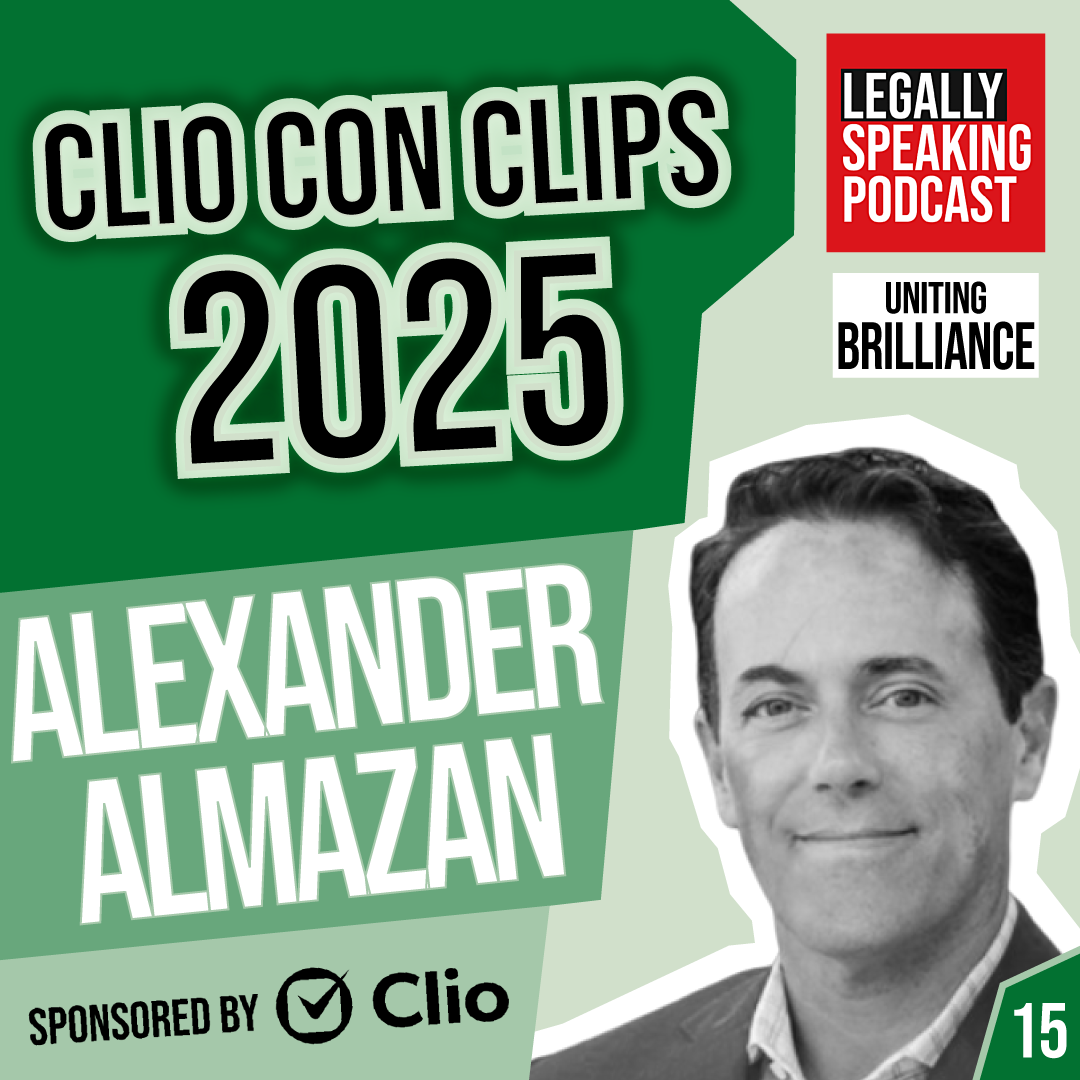
Clio Con Clips 2025 – Alexander Almazan – E15
Welcome to Clio Con Clips 2025, recorded live from Boston and proudly sponsored by Clio, the

We’re proud to be the official media partner for the first-ever edition of The Lawyers Retreat, co-founded by Kate Burt and Kirsty Pappin, which took place 13–16 May 2025 in Cala Carbo, Ibiza.
This collaboration is part of our bigger mission:
Inspiring legal minds. Transforming legal futures.
2025 is our 10x year—no playing safe, no repeating the same formula, and absolutely no following the crowd.
We’re investing in time, energy, and creativity to take the podcast global and partner with the most exciting initiatives shaping the future of law.
Following the success of our Legally On The Move: Careers, Tech & Insights from Dubai miniseries, we’re not slowing down…
✈️ Our Destination: Ibiza.
Get ready for:
💥 Strategy
💥 Scaling
💥 Sunshine
💥 Success
In today’s episode, we talk to Tom Blandford, Chief Financial Officer for law firms on a fractional basis with over two decades of experience in the field. He is also the Founder and Owner of Sursum Advisory Ltd.
You can hear Rob and Tom discussing:
– Law Firms Need Actionable Metrics, Not Just Financial Statements
– A Powerful Example from Southwest Airlines: Find Your Key Number
– Gross Profit Percentage Is a Strong Starting Point
– Understanding and Tracking Lockup and WIP
– The Best Finance Directors Are Great Storytellers
Connect with Tom here:
https://www.linkedin.com/in/tom-blandford-lawfirmcfo/
00:00
What happens when you gather the UK’s boldest legal minds on a sun-drenched retreat in Ibiza and press record?
00:07
Welcome to the Lawyers Retreat mini-series, a special edition of the Legally Speaking podcast sponsored by Clio.
00:13
We’ve partnered with the visionaries behind the Lawyers Retreat, the wonderful Kate Burr and Kirsty Papin to bring you real, unfiltered conversations from Carla Carbo, where strategy, succession and scaling and sunshine meet.
00:28
This isn’t your average CPD,It’s leadership with a view, innovation with a cocktail, and well-being with purpose.
00:35
You’ll hear from trailblazers rethinking the legal playbook with the episodes recorded poolside, mic hike, and even post-yoga.
00:44
2025 is our year of 10Xing the show.
00:47
This mini-series is just the beginning.
00:49
So let’s get into it.
00:54
Welcome to the Legally Speaking podcast, live here in Ibiza with an incredible backdrop, name, title and organisation.
01:03
I’m Tom Blanford, I’m Chief Financial Officer for law firms on a fractional basis.
01:08
I’m the owner of Sursum Advisory Limited.
01:11
You absolutely are, and I loved your session earlier.
01:14
It’s quite a lot of content we got through in a short space of time.
01:18
Can you just talk high level through the concepts you went through during your session and why they’re so important for law firms?
01:24
Yeah, I mean, the key point that I make is…
01:28
You have an accountant, you have accounts, you have balance sheets and P&Ls.
01:31
These are all wonderful documents.
01:33
I’m not knocking them for a second, but you actually need to run your business.
01:38
And in running your business, the format that HMRC require might not actually help you to run your business.
01:46
So the key point for me is…
01:48
find a number, maybe 2, maybe 3, that actually tell you what’s going on in your firm, track it, see the trend in it, and then when it goes up, down, left, right, do something about it.
02:01
AndI quite like the analogy or example you gave of Southwest Airlines to perhaps put it in context for law firms to think about the number, because it might not be what they think.
02:11
They might just think profit instantly, for example.
02:12
So you can give a bit of context to that, because I thought it was great.
02:15
Yeah, it might be profit, but you’re right, don’t default to profit.
02:19
So there’s a famous kind of MBA case study that many people might know, and it goes, it’s quite complicated, but to distill it down,Southwest Airlines, who are a sort of budget carrier in the southwest of the United States, so kind of Texas, basically.
02:34
Very large organisation, I think in the billions of dollars of revenue, I think, hundreds of planes.
02:40
And the Americans, obviously, they take planes in the way that the Brits might take buses.
02:46
So these planes are like bouncing backwards and forwards.
02:48
The same plane makes a dozen journeys a day, or whatever it happens to be.
02:52
So that’s a lot of data.
02:54
They are drowning in data.
02:57
So what do you do about that?
02:58
How do you distill that down?
03:00
And they got some Harvard MBA students, and they spent a long time looking at it.
03:03
And again, it’s quite complicated.
03:05
But they distilled the entire Southwest Airlines, which I think is hundreds of planes.
03:09
It’s thousands of journeys a day.
03:11
It’s billions of dollars.
03:12
They distilled that airline into one number.
03:16
One number.
03:18
And so the point…
03:20
I made earlier and I often make to my clients is if that ginormous blue chip organization can distill themselves down to a solitary number, admittedly with quite a lot of help from the Harvard MBA students, then…
03:33
Surely law firms can do it too, or at least maybe two, three, four numbers, something like that?
03:38
Yeah, exactly.
03:39
And what number was that specifically for Southwest Airlines?
03:41
Specifically for Southwest Airlines, it wasn’t profit, it wasn’t turnover, it wasn’t anything like that.
03:46
The number that they track that lands in the inbox of the C-suite every single morning is the number of planes that were on the tarmac yesterday for longer than an hour.
03:59
And you can think now to their business model, can’t you?
04:01
Because if that plane is going bounce, bounce, bounce, bounce, bounce between 2 mid-ranking American towns somewhere in Texas, you want it to be in the air.
04:11
So if it’s not in the air, something has gone wrong.
04:15
And that sort of leads me to my second key point, which is that e-mail lands every morning into that inbox, that’s how that C-suite spends its morning.
04:23
Right, why was that playing on the tarmac?
04:25
What went wrong?
04:26
Was it a repair issue?
04:27
Was it a staffing issue?
04:28
Was it an issue with the luggage?
04:31
Let’s fix that issue and then it won’t happen tomorrow, will it?
04:34
No, really well said.
04:35
And again, for busy law firm owners, particularly on the SME side that maybe haven’t got a large accounting team or have got a low budget, let’s say a P&L lands ondesk or a balance sheet outside of the obvious, obviously looking at sort of profit, what are some of the things you should be immediately looking at to kind of have a quick health assessment of your financials if you’re looking at it high level before perhaps bringing in someone like yourself?
04:58
Well obviously give me a ring, yeah.
05:01
I think if I’m going to pick one easy one, the one that I would suggest is gross profit.
05:06
So this is just the idea of, this was my billing, I take off the very direct cost of achieving that billing.
05:14
So basically the wages of the fee earners.
05:16
In fact.
05:17
So I take that off and I divide it through to create a percentage.
05:20
So gross profit percentage, just this is how much work I did, this was the immediate cost of doing that work, now expressed as a percentage.
05:28
Because if you can track that number again over several months, maybe between offices, maybe between departments, maybe between teams or fee earners.
05:37
Once you’ve got a couple of dozen data points of that, what is fundamentally one number, but a couple of dozen data points of it, you will spot something.
05:45
There will be an office that’s outside the norm.
05:48
There will be a particular team that’s particularly higher or lower than a sister team.
05:53
and that is telling you something about your business.
05:55
Love it.
05:55
Okay.
05:56
And then you went through again, Lockup, WIP.
05:58
Do you want to talk very high level about them and again, from clients that you’ve seen that you’ve helped improve them?
06:05
Because again, they’re quite important things that law firms should be thinking about and working on.
06:09
So can you maybe give a quick definition and go through those two?
06:11
Yeah, so WIP is work in progress.
06:13
That’s effectively time on the clock.
06:15
I imagine most firms are aware of that and are probably tracking it.
06:18
And there’s probably, basically every PMS out there has an automated report that tracks it forI will challenge the people listening to this, how often do you actually press the button that actually generates that report?
06:30
But it exists already in a format for you.
06:33
Lockup, I think, is becoming much more popular.
06:35
I hope that most people, I’ve been banging on about it and so have my colleagues for years, but lockup adds debtors to the WIP number I just discussed.
06:44
So when you add it together, what you’ve now got is if I start a matter today, it spends an amount of time sat in a timesheet, that’s WIP, then it becomes an invoice, which spends an amount of time sat as a debtor, and then that debtor gets paid.
06:56
So from the start all the way through to when it actually becomes proper cash, you know, with pictures of the monarch on it that you can hold in your hand, that is your lockup.
07:06
Now it’s usually expressed in days, so you usually divide that number through by 365.
07:11
And what are we measuring there?
07:12
What we’re saying is, if I opened it today, how long until I get paid?
07:17
And what should that be?
07:19
And what’s reasonable for the type of work that I do?
07:21
And if it’s unreasonable, why?
07:24
Because what we’re actually saying is something somewhere in your process has got stuck.
07:29
Yeah, love it.
07:30
And again, people who might be new to the idea of a fractional FD, how does it work?
07:34
Can law firms buy you for an hour or is it a year, is it six months?
07:38
Talk us through kind of the whole fractional FD concept and how it works.
07:41
Yeah, well, they can buy me for a session if they really want.
07:46
I mean, I think, and that does sometimes work and sometimes I can sort of come in, crunch a number, spot some of these problems and say, there you go.
07:54
For most of my clients, I work on some level of retainer.
07:58
So I might come back in once a quarter or once a month or once a week, oftentimes to crunch a particular problem or to try and fix a particular thing and then sort of hold their hand for a bit and then I try and head on my merry way.
08:13
I say to most of my clients, if I’m doing it right,I should sack myself within the first, let’s say, 18 months or so?
08:21
Yeah.
08:22
And take this as a compliment because of the quality of the clients and you know the legal industry so well and you just really know your head around numbers, but when people are thinking about an FD, what’s the difference between a good and a great FD?
08:35
The very, very best FDs, and I obviously know several of them, several mates, people that I trained with who have gone into a variety of FD roles, the really good onesdon’t have a calculator and don’t open Excel.
08:51
And the reason I say that is because they need to be able to explain the number to you, they need to be able to interpret that data.
08:59
They’ve probably got a team with a bunch of Excel and calculators, I’m not saying there isn’t a number to be crunched here.
09:05
But when we’re at that top, if you’re the top man or woman in finance, you should know those numbers.
09:11
You should have that data available to you.
09:13
But it’s actually about how you explain it.
09:15
How you say, well, this number has gone up, down, left, right.
09:19
Fine.
09:20
But why?
09:21
Or what does that mean?
09:22
Or what is it telling us?
09:25
So a really good FD actually is less of an accountant and more of a storyteller?
09:31
I love that and listeners of mine will know that I always say if you confuse people, you lose people.
09:35
It’s better to be clear than it is to be clever and all of these great things.
09:38
That’s a cracking example.
09:40
Thomas’s brilliant little masterclass on all things finance and accounting summed up in a very short episode.
09:44
I’m sure people have got questions.
09:45
So if they want to learn more about you or indeed the world of finance or your services, where can they go to find out more?
09:51
Feel free to chat out on your websites and your social media handles.
09:53
We’ll share them.
09:54
So you can find me on LinkedIn, it’s Tom Blanford, law firm CFO or the website is sir-sum.com.
10:02
Fantastic.
10:03
Well, it just seems me to say thank you ever so much for joining me here in Ibiza on the Legally Speaking Podcast, but for now, from all of us, over and out.
10:09
Thank you for listening to this week’s episode.
10:12
If you like the content here, why not check out our world-leading content and collaboration club, the Legally Speaking Club over on Discord.
10:22
Go to our website, www.legallyspeakingpodcast.com for the link to join our community there.
10:29
Over and out.
You may also tune in on Goodpods, Apple Podcasts, Spotify, or wherever you get your podcasts!
Give us a follow on X, Instagram, LinkedIn, TikTok and Youtube.
Finally, support us with BuyMeACoffee.
🎙 Don’t forget to join our Legally Speaking Club Community where we connect with like-minded people, share resources, and continue the conversation from this episode.
Sponsored by Clio – the #1 legal software for clients, cases, billing and more!
💻 www.legallyspeakingpodcast.com
📧 info@legallyspeakingpodcast.com
Disclaimer: All episodes are recorded at certain moments in time and reflect those moments only.

Welcome to Clio Con Clips 2025, recorded live from Boston and proudly sponsored by Clio, the

Welcome to Clio Con Clips 2025, recorded live from Boston and proudly sponsored by Clio, the

On today’s Legally Speaking Podcast, I’m delighted to be joined by Emily Monastiriotis. Emily is the

Welcome to Clio Con Clips 2025, recorded live from Boston and proudly sponsored by Clio, the

Welcome to Clio Con Clips 2025, recorded live from Boston and proudly sponsored by Clio, the

Welcome to Clio Con Clips 2025, recorded live from Boston and proudly sponsored by Clio, the

*DISCLAIMER* All episodes are recorded at certain moments in time and reflect those moments only. The podcast does not support or associate itself with any inappropriate behaviour or actions that may have occurred after recording.